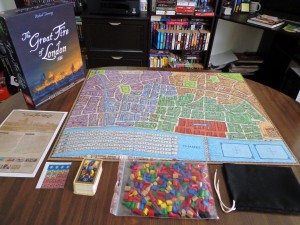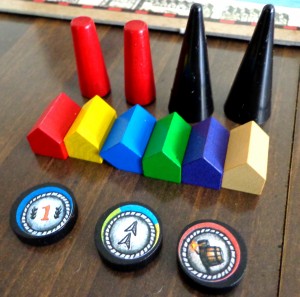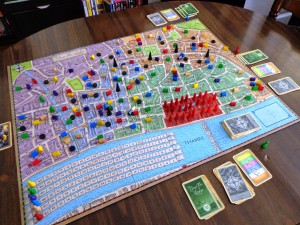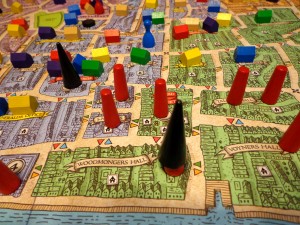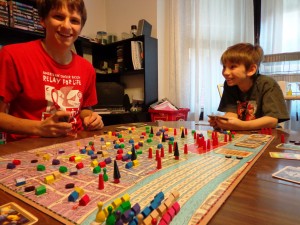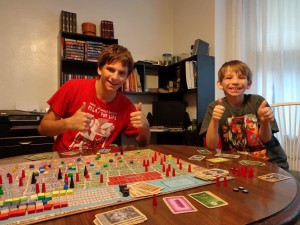In the world of real estate, location is everything. Location determines price, appeal, taxes…you name it. In some cases, it can even determine how likely your property is to go up in smoke. All I can say is, if you happen to own property on Pudding Lane, you may want to invest in a generous home owners insurance package…
The Great Fire of London 1666 is a game that assigns players the role of wealthy property owners. They own many properties all over London and all is well…until one day a baker starts a fire that puts their greed to the test. Each player will be deciding if they want to help fight the spreading fire, or let their opponents’ properties burn.
Before we get started, I wanted to thank Richard Denning from Medusa Games for sending me a free review copy. This particular copy is a 1st Edition, which was released back in 2010. There is currently a 2nd Edition in the works on Kickstarter (by Pandasaurus Games) that intends to help introduce the game to places outside of Europe and addresses certain issues with the 1st Edition. The pictures that you see in this review will be of the 1st Edition, but they will still give you an idea of how the game looks if you support and purchase the 2nd Edition. Links to both editions are included at the end of this article.
Components
Houses – Each house has its own color, letting players know who owns what property. They are scattered around the board randomly before the game begins.
Pawns – Each pawn (or property owner) is represented by a color, matching the color of the houses that are on the board.
Player Color Cards – Each player gets a color card to remind players of who is who, though in an optional variant, players can hide their color card and pick a random colored pawn. This can help prevent players from ganging up on one particular person.
Objective Cards – Each objective card has a property and point value on it. These are dealt to players before the game begins and remain a secret. Players score points if they manage to save the properties listed on their cards.
Fire Movement Cards – These cards have arrows on them and are played to move the fire around the board. These arrows have colors on them, matching the arrows that are on the board in between properties.
Tokens – Tokens are placed around the board before the game starts and provide bonuses to players as they are picked up and used.
Cones – The red cones track the fires as they spread around the board and the black cones are trained personnel that fight the fires.
Hero of London Card – This card goes back and forth between players as they put out fires. Owning this card at the game’s end will score that player points.
Fire Stack Cards – These cards are placed evenly throughout the deck and intensify the fire as they are drawn. They also guide players in how to set up the initial deck, depending on how many people are playing the game.
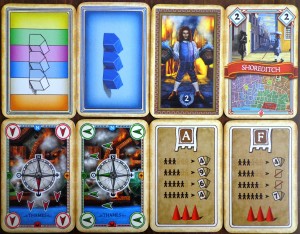
Top Row: Player Color Cards (Front and Back), Hero of London Card, Objective Card. Bottom Row: Fire Movement Cards, Fire Stack Cards.
Setup
There’s a bit involved in setting up the game. To keep the review moving, I’ll simply list the “Cliff Notes” version. There’s a link to the manual further along in the article if you want details.
To sum it up, each player gets five unique Fire Move Cards. The deck is then created via the instructions on the Fire Stack cards. Thirty houses of each color will be placed in each region, which is identified via their background color. All houses (of all colors) are used, regardless of how many people are playing. Each player gets a color card…at this point, players can either reveal their colors or hide them, depending on what kind of game they want to play. One token is placed on each district with the yellow labels, face down. Each player gets a “I”, “II”, and “III” objective card and keeps them secret. The black cones are placed anywhere players want, taking turns. Twenty-five red fire cones are placed on Pudding Lane and each player places their landowner pawn. Finally, players choose a starting player.
Gameplay
For as complex as the game setup is, player turns are fairly simple. On a player’s turn they will:
1. Expand Fire:
A player must play a card from their hand to expand the fire. Each Fire Card (except for the Intensify Fire cards) has a compass direction and colored arrows, showing how a fire is to be spread when played. Obviously, players will be trying to play cards that keeps the fire away from their properties. Only locations with two or more fire cones can spread, and when this occurs, one red cone is moved in the direction of the card. Cones can’t be moved if it is the last cone in that district.
The are also fire movement priority rules that players must follow when moving a fire cone. This is to keep players from moving fires into “dead” zones if there are tastier targets available (including their own).
When fire cones enter a location with houses on it, these house “burn down” and are placed on the score track. A player’s points decrease as more houses are placed on the track. The black cones can prevent the fire from burning down the houses if they are present at that location.
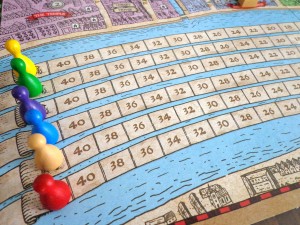
Burned down houses are placed on this track. The more of your houses that burn down, the less your score will be at game’s end.
2. Take Actions:
Each player can take four actions…
A. Move their landowner pawn (one action per space).
B. Move a trained band black cone (one action per space).
C. Put out a fire (one action per fire extinguished). The number of black cones must be equal or greater than the number of red cones in order to put out a fire, and the landowner must be present. This player receives the red cones, which awards him points at the end of the game and a chance at the Hero of London Card.
D. Demolish a district via its token (free action). Players can demolish a district that a black cone is in, though there are some limitations. Demolishing a district destroys all of the houses there, but fire can no longer spread onto or through it.
3. Draw a Fire Card (and possibly intensify the fire):
The player draws a card and brings their hand size back up to five cards. If they draw “Intensify the Fire”, three red cones are added to the board in locations already containing fire cones.
The game ends after the last Fire Stack card is drawn and players tally their points. Whoever has the most, wins the game!
It should be noted that I did not cover ALL of the rules and exceptions, though the above overview should give you a good idea on how the game is played.
The Review
I really like the idea behind this game. It plays a little like Pandemic and Flash Point: Fire Rescue, but manages to be a competitive game as opposed to a cooperative game. Players will still be contributing to the great fire and helping it spread, but at the same time they will be trying to put it out to save their own properties. This mechanic allows players to be as evil or as heroic as they wish.
By that same token, the game mechanics allow players to earn points in different ways. This opens up the floor to many ways of winning, and you never know how your opponents will react when faced with a particular situation. Will they extinguish the fire that is about to engulf your property for victory points and that Hero of London card, or will they chuckle maniacally like Wile E. Coyote while they create a trail of ACME brand alcohol from the fire to your building? Each player will be adapting and trying to figure out if by saving someone else, they’d be saving themselves in the long run.
The kids had a fun time playing and especially enjoyed watching the fire spread around the board. The anticipation of watching the fire spread to a nearby district that contained their properties kept them engaged from start to finish. I chose to play the game with hidden color cards, mainly to prevent the kids from picking favorites and from ganging up on each other. I was worried that this would cause confusion, hoping that the kids would remember that their random colored pawn may or may not represent their actual player color and the properties they own. In the end, it turned out to be okay. I pulled ahead at the last minute through some pretty questionable actions…that is…blowing up houses that weren’t mine (that were next to fires) via demolition tokens.
Overall, it is a great game that presents players with a lot of options. There is a bit of a learning curve, so patience is required when teaching the game to newcomers. We all enjoyed our time with it, but be prepared to give yourselves an extra hour or so on your first time playing. Setting up the board did take me over ten minutes, but experienced players may not have that problem. There are also a lot of little pieces, so be sure to keep small children and curious animals away from the game, if possible. Those who are easily offended by players who “play to win” by screwing over everyone else may want to steer clear…though the hidden color card variant helped to solve this problem for the most part because no one could accuse the other of intentional maliciousness. If you enjoy games like Pandemic but often yearn for competitive play instead of cooperative play, then give this game a closer look.
Final Verdict: 8/10

